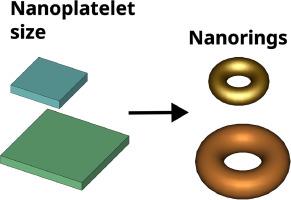Fine tuning of the spectroscopic properties of semiconductor CdSe nanorings by size
IF 4.7
2区 化学
Q2 CHEMISTRY, PHYSICAL
引用次数: 0
Abstract
The controlled synthesis of nanorings with tunable optical properties remains a challenge due to the interplay of structural parameters governing their quantum confinement. Here, we demonstrate a fine-tuned approach to fabricate nanorings with precise diameter control by leveraging the lateral dimensions of nanoplatelet precursors as a deterministic factor. Through systematic variation of the nanoplatelet size, we achieve nanorings with tailored absorption and emission profiles, directly correlating their spectral shifts with ring curvature and confinement effects. Spectroscopy reveals that the lateral size of the nanoplatelets dictates the final nanoring diameter, which in turn modulates the excitonic responses. This work establishes a scalable pathway to engineer nanoring properties for applications in nanophotonics and quantum materials, where size-dependent optical behavior is critical.

半导体碲化镉纳米片光谱特性的尺寸微调
由于控制其量子约束的结构参数的相互作用,具有可调光学性质的纳米环的受控合成仍然是一个挑战。在这里,我们展示了一种微调方法,通过利用纳米血小板前体的横向尺寸作为决定性因素来精确控制直径来制造纳米片。通过系统地改变纳米血小板的尺寸,我们获得了具有定制吸收和发射曲线的纳米纳米,并将其光谱位移与环曲率和约束效应直接相关。光谱学表明,纳米血小板的横向大小决定了最终的纳米环直径,这反过来又调节了激子反应。这项工作为纳米光子学和量子材料的纳米化特性的应用建立了一个可扩展的途径,在这些领域,尺寸依赖的光学行为是至关重要的。
本文章由计算机程序翻译,如有差异,请以英文原文为准。
求助全文
约1分钟内获得全文
求助全文
来源期刊

Journal of Molecular Structure
化学-物理化学
CiteScore
7.10
自引率
15.80%
发文量
2384
审稿时长
45 days
期刊介绍:
The Journal of Molecular Structure is dedicated to the publication of full-length articles and review papers, providing important new structural information on all types of chemical species including:
• Stable and unstable molecules in all types of environments (vapour, molecular beam, liquid, solution, liquid crystal, solid state, matrix-isolated, surface-absorbed etc.)
• Chemical intermediates
• Molecules in excited states
• Biological molecules
• Polymers.
The methods used may include any combination of spectroscopic and non-spectroscopic techniques, for example:
• Infrared spectroscopy (mid, far, near)
• Raman spectroscopy and non-linear Raman methods (CARS, etc.)
• Electronic absorption spectroscopy
• Optical rotatory dispersion and circular dichroism
• Fluorescence and phosphorescence techniques
• Electron spectroscopies (PES, XPS), EXAFS, etc.
• Microwave spectroscopy
• Electron diffraction
• NMR and ESR spectroscopies
• Mössbauer spectroscopy
• X-ray crystallography
• Charge Density Analyses
• Computational Studies (supplementing experimental methods)
We encourage publications combining theoretical and experimental approaches. The structural insights gained by the studies should be correlated with the properties, activity and/ or reactivity of the molecule under investigation and the relevance of this molecule and its implications should be discussed.
 求助内容:
求助内容: 应助结果提醒方式:
应助结果提醒方式:


